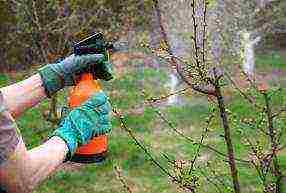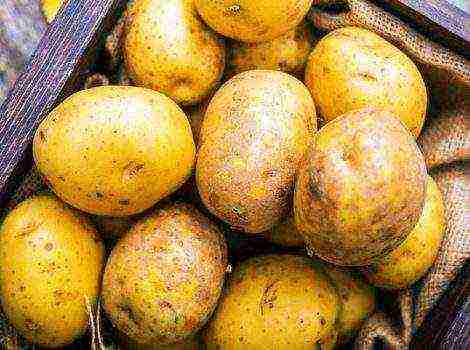Content [show]
All gardeners know that there are pepper varieties of different severity. They are sweet, spicy, and semi-hot. The degree of pungency depends on how much capsaicin (a pungent alkaloid) the vegetable contains. You can assign a variety to one or another species using the Scoville scale.
Features of peninsular peppers
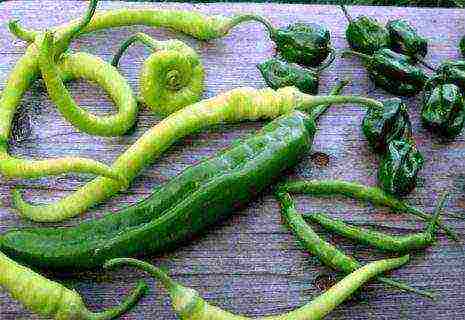
The main advantage of such crops is the ability to produce a bountiful harvest of pods with sharp walls.
Almost all peppers take a long time to ripen. Therefore, for a timely harvest, you need to start growing seedlings early. Some summer residents do this already at the end of January. For correct sowing, you can use the lunar calendar.
Important: planting material takes a long time to germinate, especially in cool soil. So before sowing, you need to prepare both the seeds and the soil.
The farming technique of peppers is different from other vegetables. Seedlings are planted only at temperatures from +15. In the north, peninsular peppers are cultivated only in greenhouses.
The fruits ripen earlier than the pungent varieties.
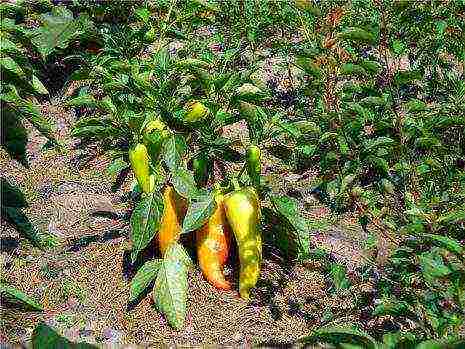
A vegetable can only grow in nutrient-rich soil, with timely feeding and adequate lighting.
As a rule, half-hot peppers are consumed fresh. It can be smoked, pickled, but dried - in rare cases. To dry the thick walls of the fruit, special conditions are needed.
The vegetable significantly improves the taste of seasonings, sauces, first courses.
The best varieties of semi-hot peppers
To determine what kind of half-hot pepper to plant in the open field and then use it for salting, just look at the photos of plants and pods. Then you can find out the variety that will take root in a particular garden. In some regions, stunted bushes grow better, in others - tall, and thirdly - spreading. The color and shape of the peppers are also important.
Black Lightning
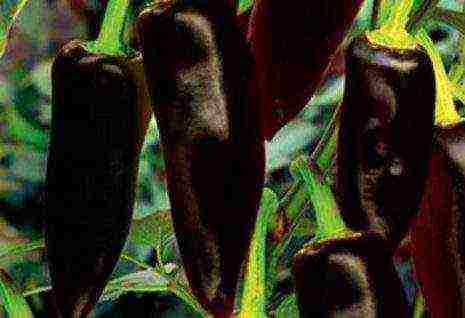
Medium ripening hybrid. Grows in greenhouses and open beds.
Differs in sprawling and tall bushes. Plant height is 1.25 m. The period of culture development is 115 days. Fruits are elongated, drooping, conical in shape. The pods change color from purple to red to black. The wall thickness is 5 mm. Fruit weight - 120 g. The spicy taste of the pods is explained by the sharp partitions.
The variety is adapted to difficult weather conditions and diseases. This is a beautiful decorative pepper that can decorate a room and a summer cottage.It bears fruit for a long time.
Red lightning

Medium hybrid with a ripening period of 110 days. It grows both in open and protected ground.
Bushes are tall, spreading, up to 1.15 m.
The pods are drooping, elongated, and have the shape of a narrow cone. Pale green peppers turn dark red over time. One fruit weighs up to 130 g. The variety is distinguished by a sharp partition, due to which the pods become more piquant. It is popular due to its beautiful appearance, high yield, content of nutrients, rich aroma.
Germination of seeds is possible at temperatures from +23.
Indian elephant
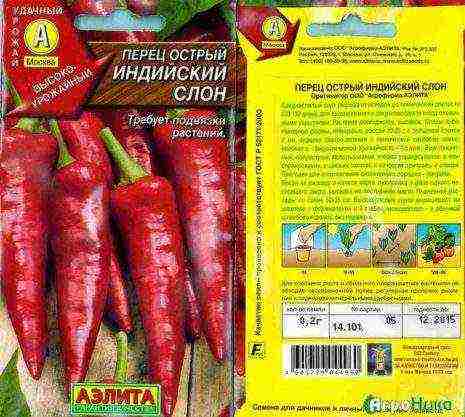
A mid-early variety popular in cooking and canning.
Adapted to any soil. Tall, spreading bushes reach 2 m in height, but there is no need for a garter. Large drooping proboscis fruits are slightly shriveled and have a semi-sharp taste.
Pepper seeds sprout quickly. The variety is resistant to most negative factors. You can collect 3.5 kg from one square. fruits.
Numex suave orang
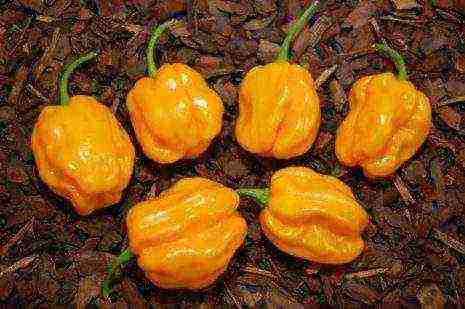
The original Habanero flavor, but not so spicy. Developed by agronomists from New Mexico specifically for gourmets who are already "fed up" with simple Habanero.
In Spanish, the name of the pepper means "soft", "gentle". The fruits are delicious, with apricot and citrus flavors. The plant has enough energy to produce a quality crop. The growing season is 115 days.
The vegetable must be grown in good light in any kind of soil.
Mulato isleno

A pure grade from the Poblano group, but not as pungent as measured on the Scoville scale.
You may be interested in:
The fruits are juicy, soft, and have the shape of a neat heart. In the process of maturation, the color changes from green to brown. The length of the peppercorns is 15 cm, the width is 7 cm. Pepper is one of the three varieties used to make Mole sauce.
The culture is grown in the garden through seedlings, and in the northern regions - in greenhouses. Fruits can be harvested 95-100 days after planting. Planting pattern - 45 cm between plants. The variety needs good lighting.
With good care, the vegetable is famous for its high yield.
Santa fe grande

The homeland of the variety is Mexico, so it is not so easy for it to adapt to the Russian climate.
Semi-hot peppers with blunt conical fruits. The height of strong bushes is about 60 cm. Fruits are colored yellow or orange-red. Thanks to the thick walls of the pods, the variety is suitable for conservation.
The plant bears fruit constantly and has a high yield if all agrotechnical recommendations are followed. Seed germination begins at a temperature of 20-30 degrees.
You need to grow through seedlings in the open field. Bushes should be spaced 45 cm apart. You need to feed the vegetable with potassium-phosphorus fertilizers.
Kohiba
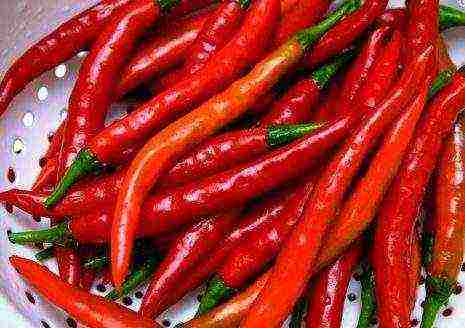
The hybrid was developed in Japan. Its unusual name repeats the famous brand of Cuban cigars.
This is an early variety that can be harvested 100 days after planting.
The height of the bush is 0.75 m, there is not much foliage.
The pods are narrow, conical, the color changes from dark green to deep red. At each stage of development, fruits have their own taste. At first, it is sweet and slightly spicy, and when fully ripe, it is very spicy. The timing of harvesting is adjusted specifically for this property.
Fruit wall thickness - 3-4 mm., Weight - up to 50 g.
Cohiba makes delicious marinades, salads and other savory dishes. The pods are a good base for sauces and seasonings.
In Russia, this variety is grown through seedlings in greenhouses and in open beds.
Thunder
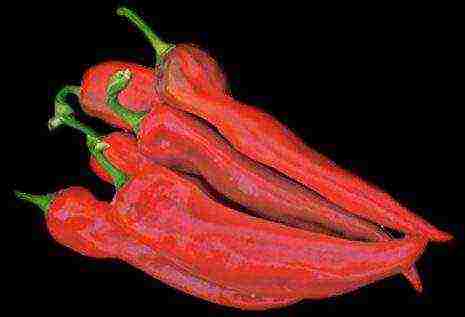
Another interesting hybrid.
The mass of long conical fruits is 140 g.
The variety belongs to the early ones, since the growing season is 90 days.
Dark green fruits, as they ripen, acquire a bright red color. They are up to 24 cm long and about 5 cm in diameter. The walls of the pods are of average thickness, about 4-5 mm. The fruits themselves are drooping, collected in a brush, which looks very attractive.They taste mildly pungent, with a peppery aroma.
The leaves reliably protect the vegetable from the heat.
The hybrid develops successfully in open and protected ground, depending on the region. This high-yielding pepper is easily processed.
The variety is resistant to transportation and can be stored for a long time.
Agrotechnics
To collect beautiful healthy fruits at the end of the season, you need to remember some of the nuances:
- Before sowing, it is advisable to treat the seeds with growth stimulants, then they will sprout faster.
- If you want to harvest the fruits from July to September, seeds for seedlings should be planted in January.
- So that the development of plants does not stop, the soil temperature during planting should be at least +16.
- In unfavorable climates, the peppers must be covered. To avoid the risk, you can only grow them in a greenhouse.
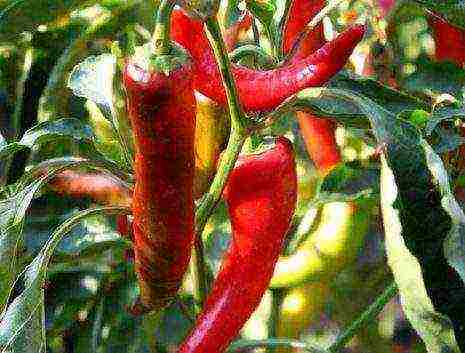
Reviews of varieties of semi-hot pepper
“I planted“ Red Lightning ”on my site. The variety can be called fruitful and the taste is excellent. The wife made a marinade out of it. From the first time, the peppers do not seem spicy, but then the bitterness is felt. The most important thing is to provide these peppers with light and warmth. They have sweetish walls, but the partition is very bitter ”(Georgy);
“When I was just starting to deal with bitter peppers, I decided to start with not the highest pungency. I took an Indian elephant and was satisfied. Large pods have grown: I salted some of them, and I froze some of them. They go well in different dishes, all of mine like it. I have already prepared seeds for next year "(Valentina)
The described varieties continue to delight gardeners with spicy taste and beauty. Each of them is used in its own way. From year to year, lovers of piquancy get acquainted with new varieties of peninsular pepper and give valuable recommendations for caring for them.
Peppers are grouped by color, bush height, pericardial thickness. The alkaloid capsaicin is a pungent substance found in all peppers. Its amount is measured on the Scoville scale.
American pharmacist William Scoville came up with a test to determine the degree of pungency of a vegetable. Based on this number, all varieties of peppers are divided into:
- sweet - have low pungency,
- peninsular - with an average number,
- sharp - show the maximum values.
Each of the types has its own purpose, use. Peppers give high yields, among them there are many thick-walled representatives. They are actively grown every year by spicy lovers.
Use and features of cultivation
The versatility of the use of fruits is confirmed by the reviews of experienced gardeners.
- semi-sharp fleshy peppers of different colors are fragrant in fresh vitamin salads, holiday cuts;
- thick-walled peppers are suitable for smoking;
- pickles seasoned with peppers always delight with a piquant taste;
- adding semi-sharp vegetables to sauces, pasta favorably distinguishes dishes with an unsurpassed aroma;
- seasonings containing semi-sharp pods for various dishes are perfectly stored and easy to use.
Experts do not recommend drying these varieties, at home it is difficult to create the desired mode to obtain high product quality results.
Spicy peppers have their own nuances: a long growing season, slow germination of seeds, requirements for soil, heat, nutrition.
Let us designate some of the features of agricultural technology of peninsular varieties.
- Presowing treatment with growth stimulants will allow the seeds to hatch faster.
- Seedlings are sown at the end of January, keeping the temperature around 23 degrees, in order to get a harvest in July-September.
- The soil of seedlings and further plantings on the site is carefully fertilized.
- The temperature of the ground during the disembarkation period should not be lower than 16 degrees so that the bushes do not stop growing.
- In adverse weather conditions, landings require shelter. You can not risk it and plant the peppers in the greenhouse.
Compliance with simple recommendations guarantees a harvest of semi-sharp pepper varieties, even for novice gardeners.
Description
For a more competent choice of varieties, we suggest that you familiarize yourself with the descriptions of plants and their peninsular fruits. Different areas allow you to grow sprawling, compact, tall or dwarf bushes. A wide range of domestic, foreign breeding varieties presents fruits of various colors.
Semi-hot peppers belong to the hot pungent group. They can be used as the main vegetable in dishes. Pungent is taken only as a seasoning. In almost all peninsular varieties, the fruits are drooping, elongated. Most of them go through color stages from green to red. The yield shown below is based on fees per square meter.
Alexinsky
Semi-sprawling bushes of medium growth, early maturing varieties. Red semi-sharp proboscis pods, red in biological maturity. Peppers with 2-3 nests, fleshy walls 3 mm, weight about 25 g. Yield up to 4 kg.
Vortex
A medium-ripening variety with lush tall bushes. The dark red fruits are narrow cone-shaped. The pericardium is 4 mm and the weight is about 40 g. The yield is up to 7 kg.
Lightning red F1
A hybrid of mid-early ripening. Large-sized tall plant, 115 cm. Semi-hot peppers of a dark red color ripen up to 130 g. Productivity in a greenhouse is up to 4 kg. The narrow-conical pod contains a septum that has a pungent piquant taste.
Lightning black F1
In greenhouses and on open ridges, fruits ripen in the middle and early stages. On spreading tall bushes, the pods are poured up to 120 g. Long narrow cones with a wall of 5 mm. The color of the semi-sharp pods is from purple to red-black. A sharp partition inside the fruit gives an original taste to the dishes. Long-term fruiting. The yield is high.
Important! The variety is resistant to diseases and climatic changes.
Thunder F1
On a very tall bush, the narrow cones of the fruit ripen relatively early. Red peppers are very long in 2-3 sockets weighing about 60 g. The pericardium is 3 mm thick. The taste is weak. The yield is high.
Indian elephant
High two-meter bushes with a lush crown are capable of bearing fruit without support. The variety is undemanding to soil. The seeds have excellent germination capacity. Large dark red proboscis fruits with strong aroma. Semi-sharp pods with a wall of 2 mm ripen up to 25 g. Productivity is about 4 kg.
Jubilee Vniisok
Lush bushes 130 cm high begin to bear fruit early.
Important! The variety does not require crown formation.
Trunk-shaped hanging peppers of red color up to 22 g have walls of 1.5 mm. Two nests inside a fragrant pod, its surface is transversely wavy. Average yield, 2 kg.
Cohiba F1
Hybrid with semi-spreading, medium-sized bushes. The pods grow very long, light red in color, reaching a weight of 49 g, pericardium 3 mm. Average yield, about 2 kg.
Bell
Medium-sized bushes bear fruit early. Semi-hot peppers are original prismatic, red-orange 90 g in weight. About 3 nests, glossy fruit pericardium 4 mm. The yield is high, 5.5 kg.
Charm
Compact semi-sprawling bushes of an early maturing variety with dark red fruits. Smooth prism-shaped peninsular peppers ripen up to 40 g, wall 3 mm. Productivity 6 kg.
Dagger F1
The plant is medium-sized, the crown is moderately leafy, ripens early. The dark red semi-sharp pod is narrow and long with two nests. Wall up to 3.5 mm and weight about 70 g. Yield 3.5 kg.
Hungarian yellow
The undersized plant has yellow fruits in technical ripeness. Ripe narrow fruit cones turn red. Their weight is about 60 g, the thickness of the pericardium is 4 mm. The yield is high, 6.5 kg.
Red Dragon
Dark red fruits from spreading bushes of medium height are suitable for drying. The wall thickness is only 1.5 mm. The mass of long proboscis peppers is 10 g. Taste is from low to medium sharp. Yield 2.5 kg.
Miracle of the Moscow region
The bush is 150 cm in height, their crown does not require molding.Early ripening of cone-shaped smooth fruits weighing 40 g, they go through stages from light yellow to red in color. Two nests are formed, wall thickness 2 mm. Each bush yields 20 pods. Productivity is about 4 kg.
Red fat man
Important! The bushes are drought-resistant, but require increased lighting.
A new variety of mildly hot peppers with medium ripening periods. The fruit cone is 18 cm long and has a pleasant peppery aroma. The fleshy wall is 7 mm, the pods reach a mass of 90 g. The yield is high.
Elephant trunk
Semi-sprawling plant with medium ripening times. Red, slightly wavy peppers with a thin flesh of 2 mm. Excellent seasoning for dishes. The yield is high.
Giant
Bushes 40 cm in height with medium ripening times. Red peppers, horn-shaped, long with a corrugated surface. The wall thickness is 1.5 mm, the weight of each is about 40 g. The yield is average.
Cardinal
The low plant belongs to the mid-season varieties. Long saber fruits in biological maturity, red color. Used for salting vegetables and fresh for seasoning. The yield is high.
This article covers the best hot pepper varieties. They are of early, middle, late ripening. They grow in various conditions. Certain types of indoor hot peppers.
The best varieties of indoor peppers
Indian summer
 Indoor pepper Indian summer
Indoor pepper Indian summer
Shade-tolerant, undemanding plant. It can grow on a loggia for several years, or on the ground as an annual plant. The bush is not high, 30-40 cm, it is covered with small spherical peppers, differing in color variety. Red is used without additional processing. The wall thickness is 3 mm, the taste is sweetish with sourness, spicy.
Hungarian yellow
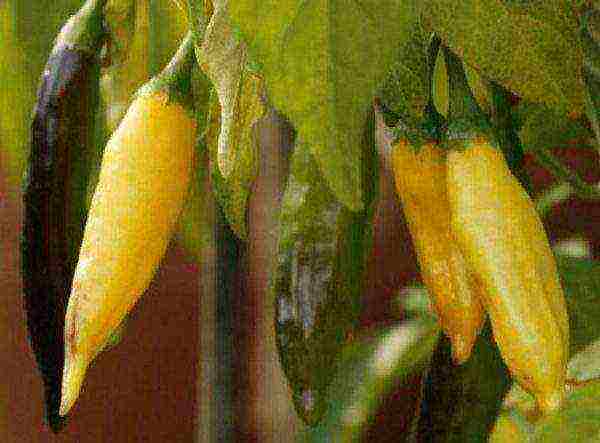 Hot peppers Hungarian yellow
Hot peppers Hungarian yellow
Early ripe, adapted to cold weather, small bush, about 25 cm... The vegetable looks like a cone hanging down. In the process of formation, yellow, when ripe, turns red. The wall thickness in the section is 4 millimeters. Juicy, sweetish, semi-sharp.
Goldfinger
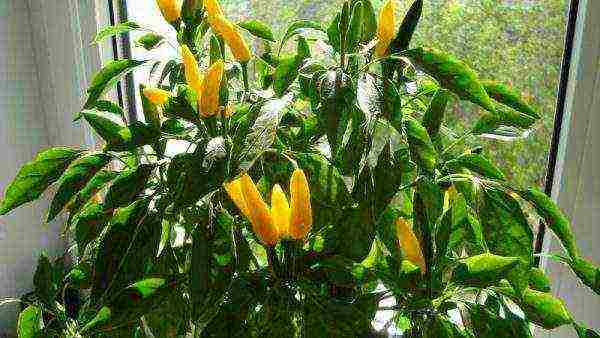 Hot Pepper Goldfinger
Hot Pepper Goldfinger
Light-loving, early ripening plant, profusely flowering, 25 cm high. Pods up to 5 cm long, yellow... It grows well and gives a lot of production on lighted windowsills.
The plant is grown as an ornamental plant with inedible fruits.
Filius Blue
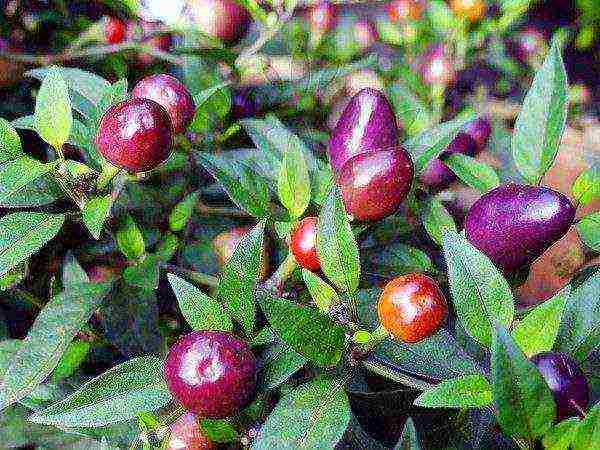 Hot pepper Filius Blue
Hot pepper Filius Blue
A beautiful perennial plant with fruits that can be eaten. The height of the bush reaches 20 centimeters, unripe peppers are purple, the red color indicates its ripeness. For the plant, it is necessary to provide a sufficient amount of light, moderate watering, moist air. If grown in an apartment and properly cared for, it will bear fruit for a whole year.
The best spicy peppers outdoors
Adjika
 Hot pepper grade Adjika
Hot pepper grade Adjika
Medium early, tall. Grows up to a meter in height. The bush is strong, lush. The fruits are large, conical, bright, red, spicy with a pleasant aroma.
For mother-in-law
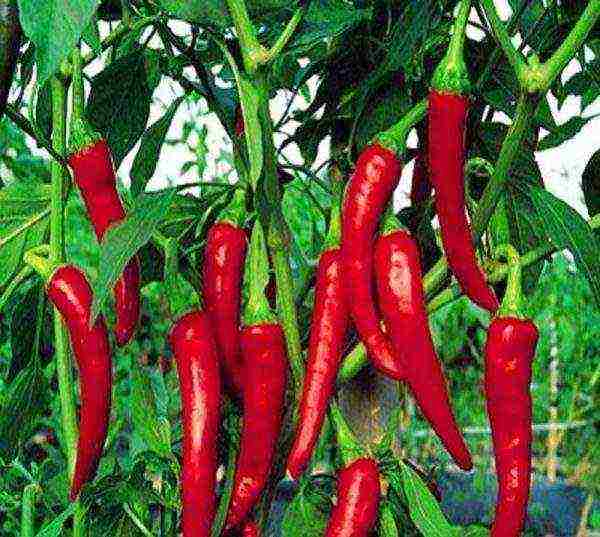 Hot pepper grade For mother-in-law
Hot pepper grade For mother-in-law
Early, with a high yield. Below average height, cone-shaped fruits, red, strong smell, pungent taste.
The Queen of Spades
 Hot pepper grade The Queen of Spades
Hot pepper grade The Queen of Spades
Mid-season. Bushes are small, spherical. There are a lot of fruits, of varying degrees of maturity and color. It looks very nice. Grows well in shady areas. The fruits are cone-like, growing upward. The taste is spicy with sweetness.
Dragon tongue
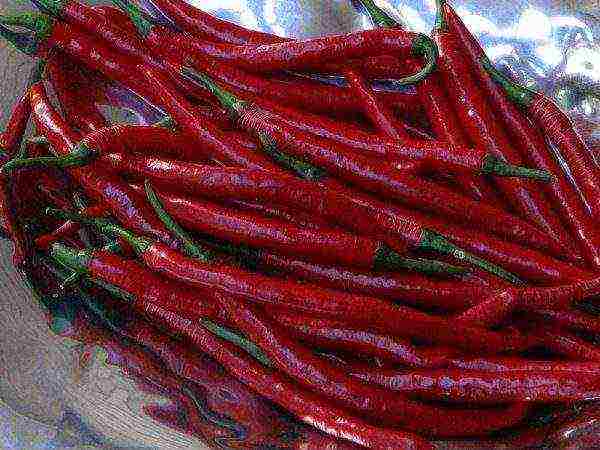 Hot Pepper Dragon's Tongue
Hot Pepper Dragon's Tongue
Mid-season. The bushy plant grows up to a meter in height, unpretentious to care for. Ripe fruits are long, rich red color, burning, with a pleasant aroma.
Goes to the production of paprika.
Bully
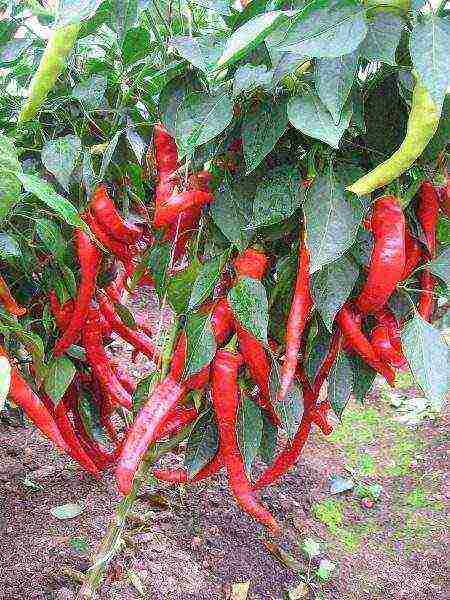 Hot pepper Bully
Hot pepper Bully
Mid-season. The bush is small, semi-spreading, grows up to 70 cm... The fruits are long, proboscis-shaped, red. In a section with a thickness of 1.5-2 mm. High resistance to cold weather, high yield. Low aroma, semi-pungent taste.
Doesn't like shadow.
The best varieties of early ripe peppers
Impala
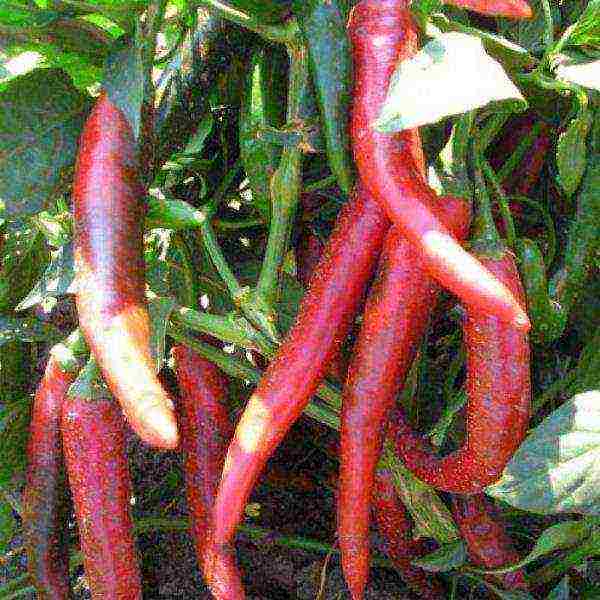 Hot Impala Pepper
Hot Impala Pepper
It tolerates heat well, ripens early, brings a large harvest. The bush is massive, reaches a height of 70 cm, dotted with peppers... They are large, weighing 80 grams. When ripe, it becomes deep red. The vegetable has an interesting taste and pungency. Reference! Resistant to tobacco mosaic virus.
Wit
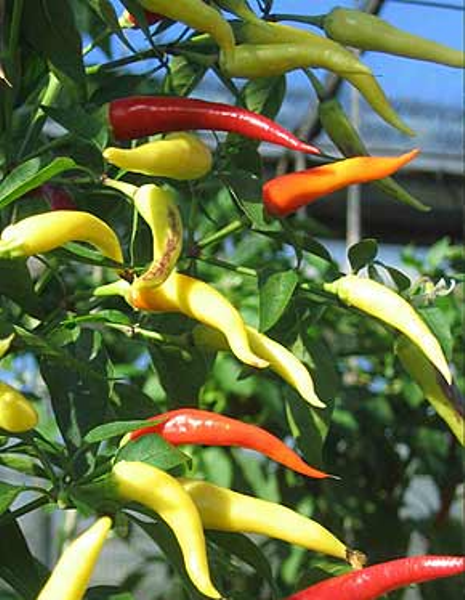 Hot pepper grade Wit
Hot pepper grade Wit
Early ripe. Grows in open and closed ground. The bush is small, medium height, large-leaved. Fruits are red, with a dark shade, shiny, conical, growing upwards. The yield is high. It is not affected by diseases and temperature changes.
The variety tolerates drought well, but cannot tolerate poor lighting. Suitable for drying, storage, salting.
Tula
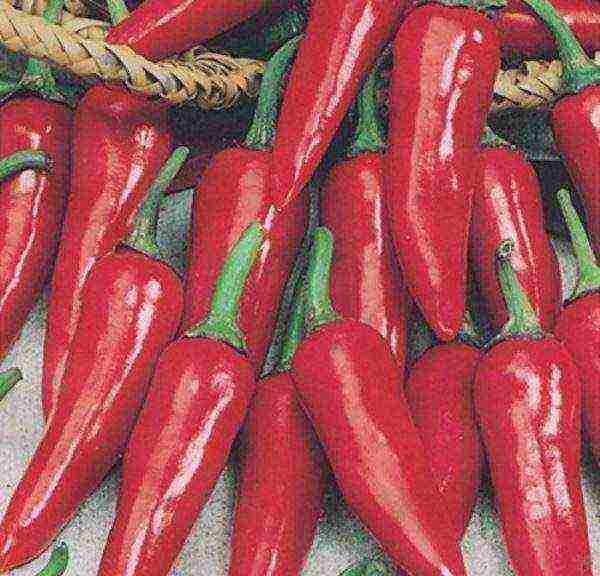 Hot pepper Tula grade
Hot pepper Tula grade
Early ripe. Grown in the open field and under a film. Medium bush, cone-shaped peppers, large, hot, red. The variety is high-vitamin, fruitful, plastic.
The best mid and late ripening varieties
Vizier
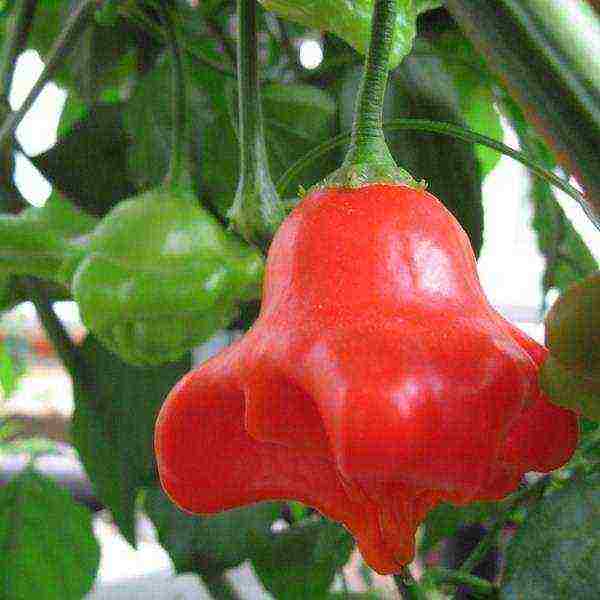 Hot pepper vizier
Hot pepper vizier
Late maturing. Grows indoors. The fruits are red, weighing up to 20 g. Medium spicy taste. The yield is good. It is used for the manufacture of paprika, salt, conservation.
Astrakhan
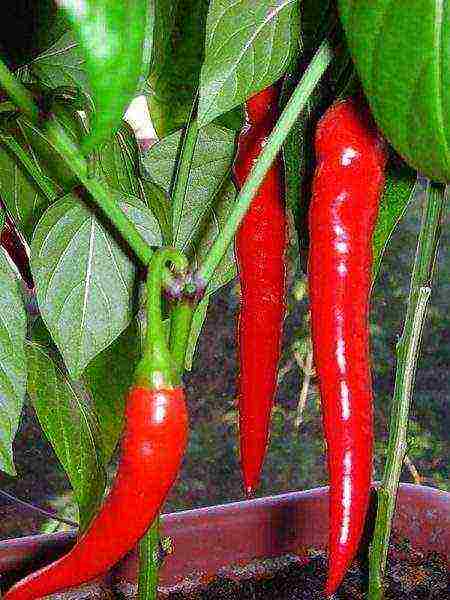 Hot pepper grade Astrakhansky
Hot pepper grade Astrakhansky
Mid-season ripening period. High yield, cultivated in open field with different climatic conditions. The fruits are small, red. The taste is acutely pungent. The pungency is determined by the capsaicin content. It is successfully used for culinary and medicinal purposes. Pepper tincture will relieve sciatica. Fresh pulp will heal abscesses. Hot pepper stimulates appetite, helps with pain, fever.
Ram horn
 Hot Pepper Lamb Horn
Hot Pepper Lamb Horn
Mid-season. Unpretentious in cultivation, but does not tolerate stagnant water. With proper care, it gives a high yield. The pods are elongated, twisted, like a ram's horn. The taste is not very pungent when well watered. If there is little watering, hot weather, the pepper will grow sharper. Suitable for trade, export.
Cayenne
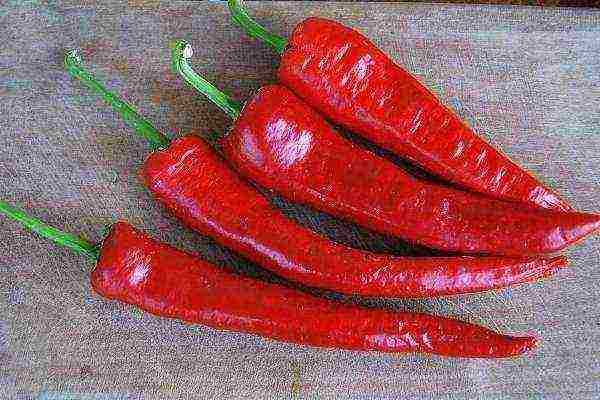 Hot pepper grade Cayenne
Hot pepper grade Cayenne
A relatively new species. It grows in greenhouses and in a room (seeds are pre-planted for seedlings). The yield is high. Fruits are thin, of medium length. The bushes are tall, reaching one and a half meters. It is imperative to tie up. The taste is relatively pungent. It is used for cooking, canning, processing into powder.
It is planted in open ground with seedlings.
Tabasco
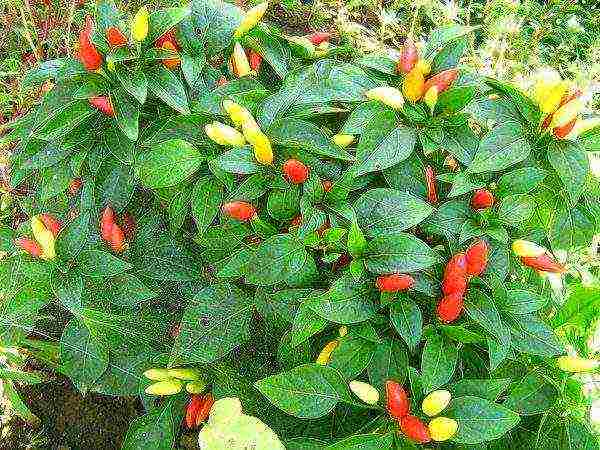 Hot pepper Tabasco
Hot pepper Tabasco
Shrub hot peppers. Grows on bushes in bunches upward. Fruits are orange-red, small. The pulp is juicy, fleshy, spicy. Productivity is high, disease resistant. The famous Tabasco sauce is made from this variety.
Popular varieties for giving
Among summer residents and owners of personal plots, Double Abundance, Superchili, Ogonyok are very famous.
Double abundance
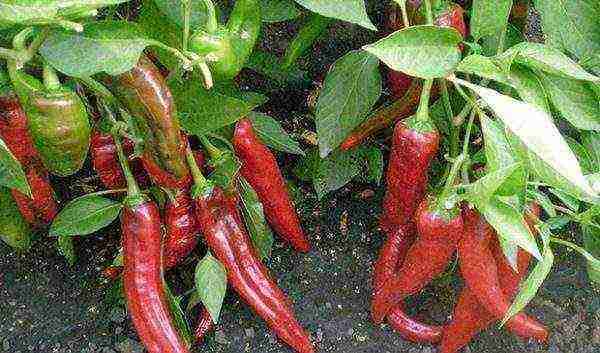 Hot Pepper Double Abundance
Hot Pepper Double Abundance
Early ripe variety. Grows in open and closed ground. Ranks first in terms of yield. Peppers are brightly colored, weigh up to 80 g... Dry peppers can be stored for several years without losing their appearance and taste. Equally good fresh and canned. Resistant to disease and heat.
Superchili
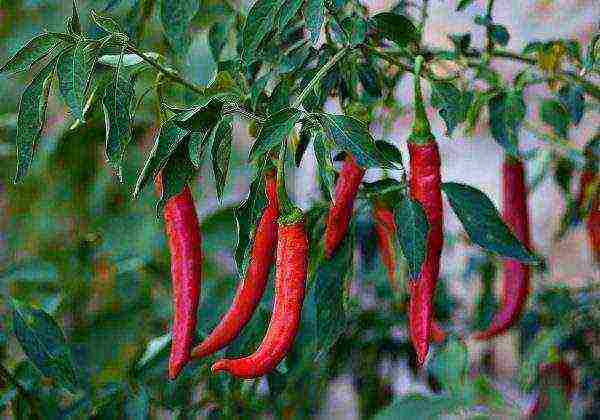 Super chili hot pepper
Super chili hot pepper
An early ripe hybrid variety. The yield is high, the taste is pungently burning. Super chili peppers are large, located under the foliage. Fully ripe fruits of almost cherry color... Eaten fresh, dried, salted.
This variety should not be grown next to other peppers in order to avoid over-pollination of the plants.
Twinkle
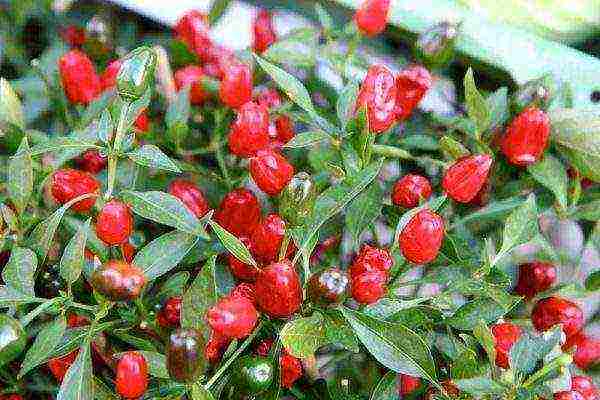 Hot pepper Spark
Hot pepper Spark
Spark is a fairly well-known, popular variety. Medium early ripening. Feels great outdoors and greenhouses. Fruits are not large enough, bright red. There are many of them on the bushes, they look like bright lanterns. Taste with special pungency and peppery aroma. This is due to the increased content of coloring pigments and solids. The fruits are dried naturally, stored in a glass container under a lid.
Resistant to bacteriosis and verticellosis wilt.
From such an abundance of piquant peppers, you can choose those that are suitable for taste, color, ripening time, types of storage, specifically for this site.
If you prefer mild hot pepper varieties, we offer you a description of the most interesting of them, in our opinion.
Low-spicy pepper varieties
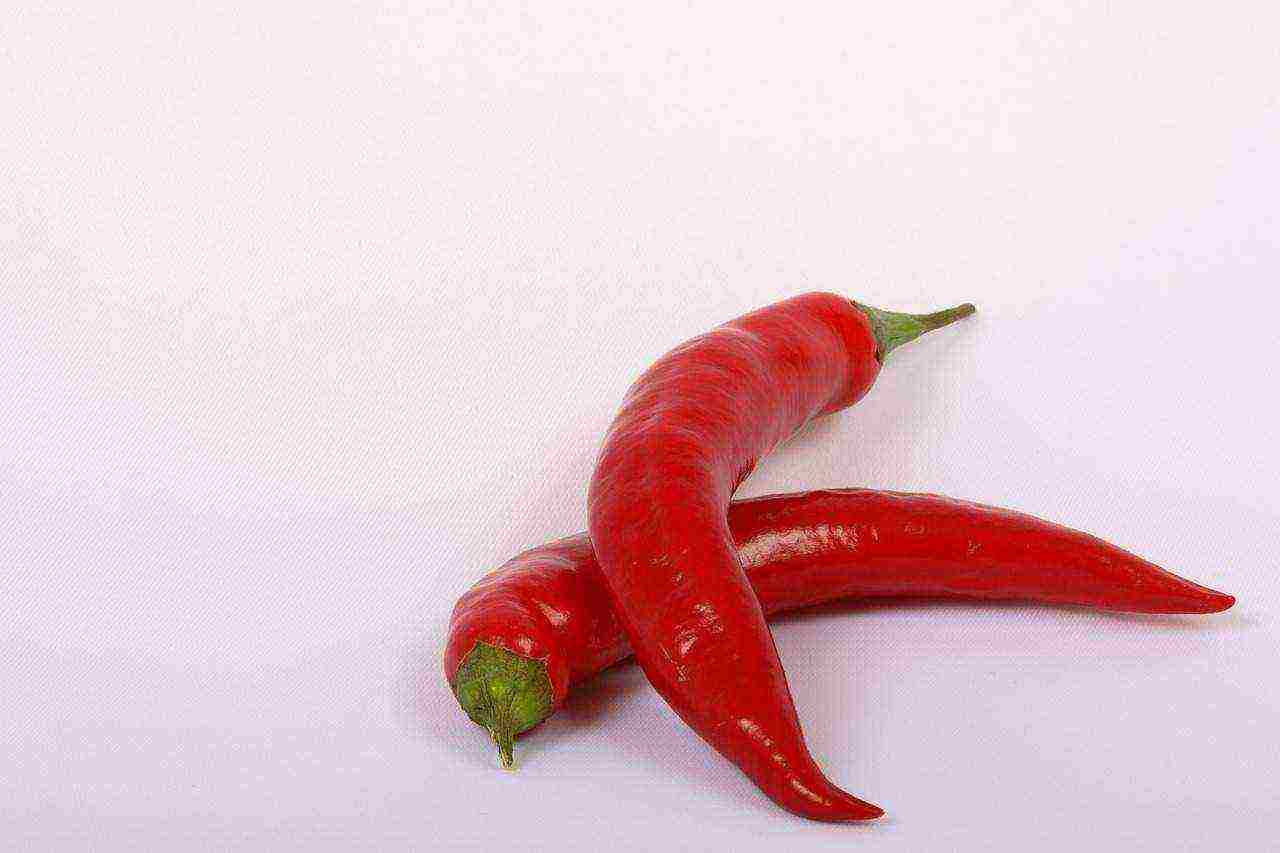
Variety LIGHTNING RED f1
An early ripe hybrid, suitable for canning and cooking various dishes. Recommended for growing in open ground and under film shelters. The plant is sprawling, 100-115 cm high.
The fruit is drooping, narrow-conical, long, highly glossy, greenish-white in technical ripeness, and dark red in biological ripeness.
The number of sockets is 2-3. Fruit wall thickness 3-4 mm. Fruit weight 100 g. Peppery aroma. The taste is semi-sharp.
Variety TANDER f1
The hybrid is early ripe, suitable for fresh use and canning. Recommended for growing in open ground and under film shelters. The plant is tall - very tall.
The fruit is drooping, narrow-conical, very long, slightly wrinkled, glossy, color in technical ripeness is light green to green, in biological ripeness it is red.
The number of nests is 2-3. Fruit weight - 55 g (according to the originator's data up to 150 g), wall thickness - 3 mm. The taste is weak.
Variety LIGHTNING BLACK f1
An early ripe hybrid suitable for canning and home cooking. Recommended for growing in open ground and under film shelters. The plant is sprawling, 100-125 cm high.
The fruit is drooping, narrow-conical, long, highly glossy, dark purple in technical ripeness, dark red in biological ripeness.
The number of sockets is 2-3. Fruit wall thickness 3-5 mm. Fruit weight 80-90 g. Peppery aroma. The taste is semi-sharp.
Weak grade of bitter pepper ANNIVERSARY VNIISSOK
An early ripe variety, suitable for canning and home cooking. Recommended for growing in open ground and under film shelters. The period from full sprouting to the beginning of the technical ripeness of the fruit is 100 days. The plant is semi-spreading, 100-130 cm high. It does not require the formation of plants.
The fruits are drooping, proboscis-shaped, with a transverse wavy surface, glossy, dark green in technical ripeness, and red in biological ripeness.
Number of nests 2. Fruit wall thickness 1.5 mm. Fruit weight 22 g. The taste is semi-sharp. The aroma is strong. The yield of marketable fruits when grown under film shelters is 2.1 kg / sq.m.
KOHIBA f1 semi-hot pepper variety
Mid-season hybrid, suitable for canning and home cooking. Recommended for growing in open ground and under film shelters. The plant is semi-spreading, of medium height to high.
The fruit is drooping, narrow-conical, long to very long, of medium diameter, smooth, glossy, color in technical ripeness is greenish-white, in biological ripeness - light red.
Fruit weight 49 g, wall thickness 3.0 mm. The taste of the fruit is semi-sharp. The yield of marketable fruits in the open field is 2.0 kg / sq.m. Resistant to TMV.
Hot pepper variety INDIAN ELEPHANT
Mid-season variety, suitable for canning and home cooking. Recommended for growing in open ground and under film shelters. The plant is sprawling, tall.
The fruit is drooping, proboscis, slightly wrinkled, highly glossy, color in technical ripeness is light green, in biological ripeness - dark red.
Fruit weight 22-25 g, wall thickness 2 mm. The number of sockets is 2-3. The taste of the fruit is semi-sharp. The yield of marketable fruits under film shelters is 3.0-3.5 kg / sq.m.
Pepper variety BELL
An early ripe variety, suitable for canning and home cooking. Recommended for growing in open ground and under film shelters. The plant is semi-spreading, of medium height.
The fruit is drooping, prismatic, smooth, glossy to highly glossy, color in technical ripeness is greenish-white, in biological ripeness - red.
Fruit weight 70-90 g, wall thickness 4 mm. The number of sockets is 2-3. The taste of the fruit is semi-sharp. The yield of marketable fruits under film shelters is 4.0-5.5 kg / sq.m.
Variety ALEKSINSKY
An early ripe variety, suitable for canning and home cooking. Recommended for growing in open ground and under film shelters. The plant is semi-spreading, of medium height.
The fruit is drooping, proboscis, smooth, highly glossy, the color in technical ripeness is green, in biological ripeness it is red.
Fruit weight 20-25 g, wall thickness 3 mm. The number of sockets is 2-3. The taste of the fruit is semi-sharp. The yield of marketable fruits under film shelters is 3-4 kg / sq.m.
VORTEX variety
Mid-season variety, suitable for canning and home cooking. Recommended for growing in open ground and under film shelters. The plant is semi-spreading, tall.
The fruit is drooping, narrow-conical, smooth, glossy, the color in technical ripeness is dark green, in biological ripeness it is dark red.
Fruit weight 40 g, wall thickness 4 mm. The taste of the fruit is semi-sharp. The yield of marketable fruits under film shelters is 7.2 kg / sq.m.
SHARM Variety
Recommended for growing in open ground and under film shelters. An early ripe variety, suitable for home cooking and canning. The plant is semi-sprawling, undersized.
The fruit is drooping, prismatic, smooth, highly glossy, the color in technical ripeness is dark green, in biological ripeness it is dark red.
Fruit weight 40 g, wall thickness 3 mm. The taste of the fruit is semi-sharp. The yield of marketable fruits is 6 kg / sq.m.
Bitter pepper variety KORTIK f1
An early ripe hybrid, suitable for canning and pickling. Recommended for growing in open ground and under film shelters. The plant is semi-spreading, of medium height.
The fruit is drooping, narrow-conical, long, smooth, highly glossy, dark green in technical ripeness, dark red in biological ripeness.
Number of nests - 2. Fruit weight - 45-65 g, wall thickness - 2.5-3.5 mm. The taste is semi-sharp. The yield of marketable fruits under film shelters is 3.2-3.5 kg / sq.m.
VARIETY HUNGARIAN YELLOW
An early ripe variety, suitable for canning and home cooking. Recommended for growing in open ground and under film shelters. The plant is closed, undersized.
The fruit is drooping, narrow-conical, smooth, glossy, yellowish in technical ripeness, red in biological ripeness.
Fruit weight 60 g, wall thickness 4 mm. The taste of the fruit is semi-sharp. The yield of marketable fruits under film shelters is 6.4 kg / sq.m.
Variety RED DRAGON
An early ripe variety, suitable for canning and home cooking, for drying and storage. Recommended for growing in open ground and under film shelters. The plant is spreading, of medium height.
The fruit is drooping, proboscis, long, slightly wrinkled, highly glossy, dark green in technical ripeness, dark red in biological ripeness.
Fruit weight 10 g, wall thickness 1.0-1.5 mm. The taste in technical ripeness is low-sharp, in biological ripeness it is of medium sharpness. The yield of marketable fruits is 2.3-2.5 kg / sq.m.
Variety LIGHTNING GOLD f1
An early ripe hybrid suitable for canning and home cooking. Recommended for growing in open ground and under film shelters. The plant is sprawling, 100-120 cm high.
The fruit is drooping, narrow conical, very long, highly glossy, dark green in technical ripeness, dark yellow in biological ripeness.
The number of sockets is 2-3. Fruit wall thickness 6 mm. Fruit weight 100 g (up to 200 g). Strong peppery aroma. The taste is semi-sharp. The yield of marketable fruits when grown under film shelters is up to 8 kg / sq.m.
Variety of semi-hot bitter pepper MIRACLE OF THE MOSCOW REGION
An early ripe variety, suitable for canning and home cooking. Recommended for growing in open ground and under film shelters. The period from full sprouting to the beginning of the technical ripeness of the fruit is 100 days. The plant is indeterminate, semi-spreading, 135-150 cm high. It does not require the formation of plants.
The fruit is drooping, conical, smooth, highly glossy, light yellow in technical ripeness, red in biological ripeness.
Number of nests 2. Fruit wall thickness 2.0 mm. Fruit weight 36.5 g. Up to 20 fruits are tied on the bush. The taste is semi-sharp. The aroma is strong. The yield of marketable fruits when grown under film shelters is 3.6-3.9 kg / sq.m.
(Visited 1,196 times, 1 visits today)
loading ...
: house, garden, vegetable garden, farm, flower garden, home kitchen
